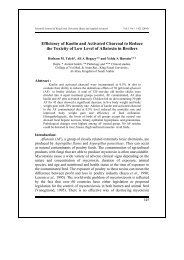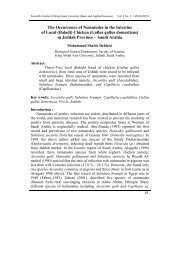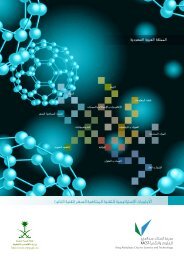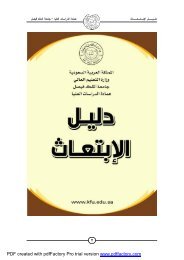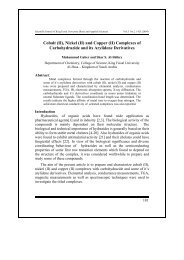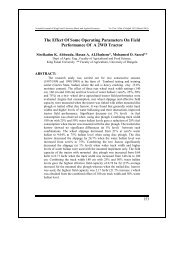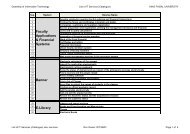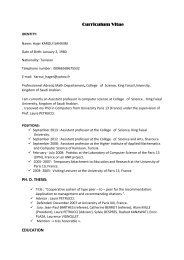Gifted Child Quarterly
Gifted Child Quarterly
Gifted Child Quarterly
You also want an ePaper? Increase the reach of your titles
YUMPU automatically turns print PDFs into web optimized ePapers that Google loves.
Garces-Bacsal 149Borland, J. H., Schnur, R., & Wright, L. (2004). Economically disadvantagedstudents in a school for the academically gifted: Apostpositivist inquiry into individual and family adjustment. InA. Y. Baldwin (Ed.), Culturally diverse and underserved populationsof gifted students (pp. 191-224). Thousand Oaks, CA:Corwin Press.Church, A. T. (1987). Personality research in a non-Western culture:The Philippines. Psychological Bulletin, 102, 272-292.Colangelo, N., Kerr, B., Christensen, P., & Maxey, J. (2004). Acomparison of gifted underachievers and gifted high achievers.In S. M. Moon (Ed.), Social/emotional issues, underachievement,and counseling of gifted and talented students (pp. 119-132).Thousand Oaks, CA: Corwin Press.Cornell, D. G. (2004). High ability students who are unpopularwith their peers. In S. M. Moon (Ed.), Social/emotional issues,underachievement, and counseling of gifted and talented students(pp. 31-42). Thousand Oaks, CA: Corwin Press.Crespi, T. D., & Politikos, N. N. (2008). Personality assessmentwith adolescents: Challenges and guidelines. Adolescence, 43,593-606.Cross, T. L., & Burney, V. H. (2005). High ability, rural and poor:Lessons from Project Aspire and implications for school counsellors.Journal of Secondary <strong>Gifted</strong> Education, 16, 148-156.Dana, R. H. (1986). Thematic apperception test used with adolescents.In A. I. Rabin (Ed.), Projective techniques for adolescentsand children (pp. 14-36). New York: Springer.Dettman, D. F., & Colangelo, N. (2004). A functional model forcounseling parents of gifted students. In S. M. Moon (Ed.),Social/emotional issues, underachievement, and counseling ofgifted and talented students (pp. 213-220). Thousand Oaks, CA:Corwin Press.Dunn, R., Milgram, R. M., & Price, G. E. (1993). Teaching andcounseling gifted and talented adolescents: An internationallearning style perspective. London: Praeger.Espiritu, Y. L. (2003). Home bound: Filipino American lives acrosscultures, communities, and countries. Berkeley: University ofCalifornia Press.Ford, D. Y. (2002). Racial identity among gifted African American students.In M. Neihart, S. M. Reis, N. M. Robinson, & S. M. Moon(Eds.), The social and emotional development of gifted children:What do we know? (pp. 155-164). Waco, TX: Prufrock Press.Franklin, K. W., & Cornell, D. (1997). Rorschach interpretationwith high-ability adolescent females: psychopathology or creativethinking? Journal of Personality Assessment, 68, 184-196.Gallucci, N. T. (1989). Personality assessment with children of superiorintelligence: Divergence versus psychopathology. Journal ofPersonality Assessment, 53, 749-760.Gloria, A. M., & Ho, T. A. (2003). Environmental, social, andpsychological experiences of Asian American undergraduates:Examining issues of academic persistence. Journal of Counselingand Development, 81, 93-106.Gross, M. U. M. (2002). Social and emotional issues for exceptionallyintellectually gifted students. In M. Neihart, S. M. Reis,N. M. Robinson, & S. M. Moon (Eds.), The social and emotionaldevelopment of gifted children: What do we know (pp. 19-30).Waco, TX: Prufrock Press.Gross, M. (2004). Exceptionally gifted children (2nd ed.). New York:Routledge.Gust, K. (1996). Assessing the social and emotional needs of thegifted: using the children’s self-report and projective inventoryas a potential tool. <strong>Gifted</strong> <strong>Child</strong> Today, 19(5), 38-40.Harris, C. R. (1993). Identifying and serving recent immigrant childrenwho are gifted (Report No. EDO-EC-93-3). Washington,DC: Office of Educational Research and Improvement. (ERICDocument Reproduction Service No. ED358676)Hebert, T. (1991). Meeting the affective needs of bright boys throughbibliotherapy. Roeper Review, 13, 207-212.Hebert, T., & Kent, R. (2000). Nurturing social and emotionaldevelopment in gifted teenagers through young adult literature.Roeper Review, 22, 167-171.Johnson, N. (1994). Use of the WISC-R with disadvantaged giftedchildren: Current practice, limitations, and ethical concerns.San Diego, CA: San Diego Unified School District. (ERIC DocumentReproduction Service No. ED368097)Kennedy, W. (1962). MMPI profiles of gifted adolescents. Journalof Clinical Psychology, 18, 148-149.Kitano, M., & Dijosia, M. (2002). Are Asian and Pacific Americansoverrepresented in programs for the gifted. Roeper Review, 24(2), 76.Kloosterman, V. (1999). Socio-cultural contexts for talent development:A qualitative study on high ability, Hispanic, bilingualstudents. Storrs, CT: University of Connecticut. (ERIC DocumentReproduction Service No. ED443214)Lagmay, A. V. (1965). Philippine Thematic Apperception Test.Quezon City: University of the Philippines Press.Lazo, L. S., & Ventura, E. R. (1987). Scaling the PhilippineThematic Apperception Test (PTAT) for needs achievement,affiliation, power. In A. J. Carlota & L. S. Lazo (Eds.), Psychologicalmeasurement in the Philippines: A book of readings(pp. 199-213). Quezon City, Philippines: UP PsychologyFoundation.Louttit, C. M. (1947). The application of the Rorschach test to youngchildren. Journal of Educational Psychology, 38, 190-191.Malgady, R. G., Constantino, G., & Rogler, L. H. (1984). Developmentof a thematic apperception test (TEMAS) for urban Hispanic children.Journal of Consulting and Clinical Psychology, 52, 986-996.Masten, W., & Morse, D. (1995). Factor structure of the WISC-Rfor Mexican-American students referred for intellectually giftedassessment. Roeper Review, 18, 130-131.McBee, M. T. (2006). A descriptive analysis of referral sources forgifted identification screening by race and socioeconomic status.Journal of Secondary <strong>Gifted</strong> Education, 17, 103-111.Mendaglio, S. (2003). Heightened multifaceted sensitivity of giftedstudents: Implications for counseling. Journal of Secondary<strong>Gifted</strong> Education, 14, 72-82.Mitchell, B. (1982). Identification of the gifted and talented: A screeningprocess with special emphasis on the culturally different. In J.Abbott (Ed.), Identifying and educating the disadvantaged giftedDownloaded from http://gcq.sagepub.com at Brunel University on June 9, 2010



